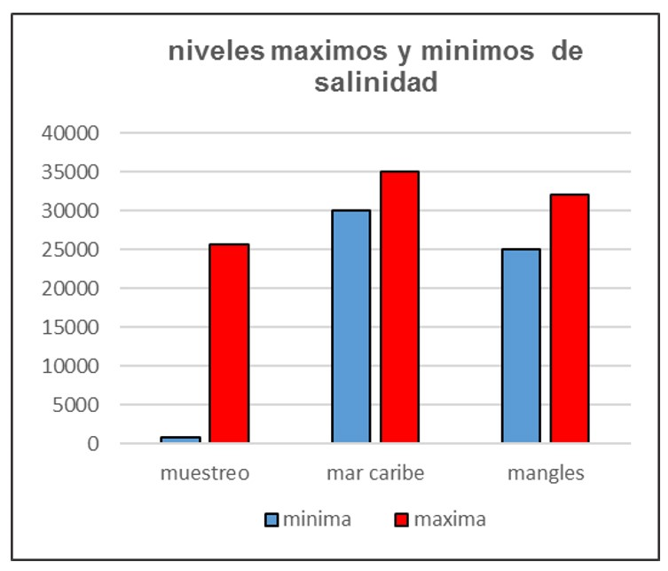Impact of climate change on mangrove ecosystems in the gua basin of Manzanillo
Main Article Content
Abstract
Continuous climate change has caused variations in the exchange of freshwater with the hydro-regulatory strip of the coastal zone, increasing saline intrusion and directly affecting mangroves, which are coastal ecosystems of great ecological and socioeconomic value.
Understanding and monitoring the hydrological processes that sustain mangroves is essential for developing effective management and conservation strategies for these valuable coastal wetlands, especially in the context of climate change and anthropogenic pressures.
Salinity observations in the mangrove ecosystems of the Gua basin in Manzanillo reveal that variations in salinity are closely related to dry and wet cycles. During dry periods, salinity increases due to reduced freshwater availability, which can affect the growth of mangrove species. In contrast, wet periods favor the recovery of these ecosystems, promoting organic matter accumulation and enhancing their ecological health and functionality.
This study will serve as a starting point for establishing a long-term monitoring program to evaluate changes in salinity levels, freshwater flows, and mangrove responses, thereby understanding the system's dynamics. It will promote an integrated water resource management approach that balances the system's needs and implement environmental education and public awareness programs about the importance of mangroves and the necessity of their conservation
Downloads
Article Details

This work is licensed under a Creative Commons Attribution-NonCommercial 4.0 International License.
References
Barbier, E. B., Hacker, S. D., Kennedy, C., Koch, E. W., & Silliman, B. R. (2011). The value of estuarine and coastal ecosystem services. Ecological Economics, 70(2), 203-213. https://doi. org/10.1016/j.ecolecon.2010.11.003.
Cárdenas, S. I. (2012). Tesis - Universidad Veracruzana. Recuperado de https://www.uv.mx/pozarica/mmemc/files/2012/10/SANDRA-IVONNE-CARDENAS-DEL-ALGEL.pdf
Comisión Nacional Forestal. (2018). Manglar, riqueza de especies. Recuperado de https://www.gob.mx/conafor/es/articulos/manglar-riqueza-de-especies?idiom=es
Cruz, M. A., González, J. A., & Pérez, A. (2019). Impacto del cambio climático en los ecosistemas de manglares en Cuba. Revista Cubana de Ciencias Ambientales, 11(1), 45-56.
Duke, N. C., Ball, M. C., & Ellison, J. C. (2007). Factors influencing biodiversity and distribution of mangrove flora. Mangrove Ecosystems: A Global Perspective, 1-29.
Duke, N. C., Ball, M. C., & Ellison, J. C. (2007). Factors influencing biodiversity and distribution of mangrove species. In Mangroves: A global perspective (pp. 1-30).
González, J., Rodríguez, M., & Pérez, J. (2017). Caracterización físico-química de las aguas costeras de Cuba: implicaciones para la gestión ambiental. Ciencias Marinas, 43(3), 321334. https://doi.org/10.7773/cm.v43i3.2531.
González, J., Rodríguez, M., & Pérez, J. (2019). Caracterización físico-química de las aguas costeras de Cuba: implicaciones para la gestión ambiental. Ciencias Marinas, 43(3), 321-334.
IPCC (2021). Climate Change 2021: The Physical Science Basis. Contribution of Working Group I to the Sixth Assessment Report of the Intergovernmental Panel on Climate Change. Cambridge University Press. https://doi. org/10.1017/9781009157896
ITTO. (n.d.). Conociendo los manglares y selvas inundables. Recuperado de https://www.itto.int/files/itto_project_db_ input/3000/Technical/Conociendo%20los%20manglares%20y%20selvas%20inundables.pdf
Maza, A. V., Gutiérrez, J. R., & Cárdenas, E. (2015). Respuesta de los manglares a la variabilidad climática en la región de Tumbes, Perú. Revista de Biología Tropical, 63(2), 123-135. https://doi.org/10.15517/rbt.v63i2.15042.
Neira, M. (2006). Estudio hidrogeoquímico de las aguas subterráneas en el sur de México. Recuperado de https://repositorio.uchile.cl/tesis/uchile/2006/neira_m/sources/neira_m.pdf.
Pérez, A., Martínez, L., & Torres, R. (2020). Impacto de las variaciones estacionales en la salinidad de los manglares cubanos. Revista de Ecología Tropical, 56(2), 145-158.
Redalyc. (2019). Indicadores de calidad físico-química de las aguas residuales del estado de Oaxaca. Recuperado de https:// www.redalyc.org/journal/573/57363391013/57363391013. pdf..
Rodríguez, C., López, E., & Hernández, J. (2021). Estrategias de adaptación de los manglares ante el cambio climático en Cuba. Revista Cubana de Ciencias Biológicas, 10(1), 23-34.
Tovilla-Hernández, C., & Orihuela-Belmonte, E. (2002). Reforestación de manglares en Chiapas. Ra Ximhai, 7(3), 361-370.
Uribe, M., & Urrego, J. (2011). Gestión ambiental de los ecosistemas de manglar: Aproximación al caso colombiano. Gestión y Ambiente, 59, 1-30.
Yanez-Espinosa, L., & Flores, J. (2015). The Impact of Climate Change on Mangrove Forests. Environmental Management, 56(2), 1-10.

